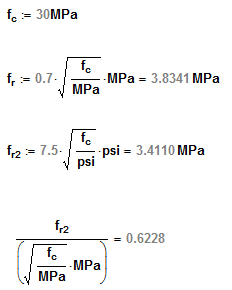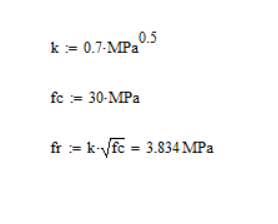@IDS:
The problem with "empirical formulae" such as your example where the tensile strength of concrete is given by:
f'ct = 0.36 * (f'c)^0.5
is that they are dimensionally inconsistent, and they only work if you enter the parameters in the required units. (The above example is from AS 3600, and gives the tensile strength in MPa if you enter the compressive strength in MPa - clearly it doesn't work if you enter the compressive strength in any other units, so the corresponding "empirical" relationship in American codes would use a different factor to obtain the equivalent "empirical fit" between compressive strength and tensile strength.)
My preferred approach for handling "empirical formulae" in dimensionally-aware software such as Mathcad is to define all parameters with their correct units, then whenever a dimensional parameter appears in an empirical formula, you divide all parameters by their units, making all parameters non-dimensional, and then finally multiply the whole expression by the implied units. E.g. for the above example, I would write:
f'c = 32 MPa
f'ct = 0.36 (f'c / MPa)^0.5 MPa
The first expression means that Mathcad "knows" that f'c carries units of "stress" or "pressure", and it will be quite happy whether you define it in MPa, psi, kgf/cm2, or whatever.
In the second expression, dividing f'c by its implied units makes it unit-less; so the expression can be evaluated correctly; multiplying the whole expression by MPa means that the solution for f'ct carries the required units.
If I want to know what the tensile strength is in psi or kgf/cm2, I just ask Mathcad to present the solution in alternative units of my choice. (This is very handy when doing a calculation to Australian or European codes, but needing to be understood by an American reviewer, for example.) If I want to know the tensile force carrying capacity of my concrete member, I multiply f'ct by the area of the section (which again carries appropriate units, whether it is square millimetres, square inches, or acres), and I can get the tensile capacity in kN, kips, kgf, or whatever.


